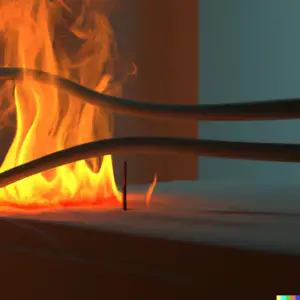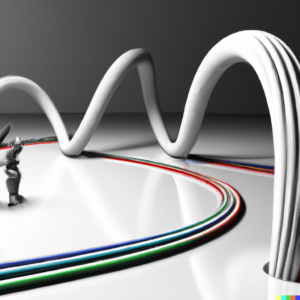Electric cables are essential components in modern society, powering everything from our homes and workplaces to transportation systems and communication networks.
However, when cables are in use, they can sometimes generate heat, which can pose a significant risk to both people and equipment.
In this article, we will explore what causes electric cables to heat up and the implications of this phenomenon.
Table of Contents
What is an Electric Cable?
Before we delve into the causes of cable heating, it’s essential to understand what an electric cable is.
An electric cable is a bundle of insulated wires used to transmit electrical power or signals.
Typically, a cable consists of a conductor, which is made of copper or aluminum, an insulating material such as PVC or rubber, and a protective sheath.
The conductor is part of the cable that carries the electric current.
What Causes an Electric Cable to Heat Up?

Electric cables heat up when there is a resistance to the flow of electric current through the conductor.
This resistance generates heat energy, which is dissipated as the current flows through the cable.
The amount of heat generated is proportional to the resistance of the cable and the amount of current flowing through it.
This principle is known as Joule’s law.
Several factors can contribute to resistance in an electric cable, resulting in heat generation:
Overloading
When too much current flows through an electric cable, it can cause it to heat up. Overloading can occur when too many appliances or devices are connected to a single circuit, or when the cable is not designed to handle the load. You should choose the right cable size for the loads to prevent any overloading.
Overloading can cause the cable’s insulation to break down, creating a fire hazard.
Faulty Wiring
Incorrect installation or damaged wiring can cause resistance in an electric cable.
This can occur when wires are not connected correctly, or when cables are bent or twisted, causing the conductor to break.
Faulty wiring can cause a cable to heat up and, in extreme cases, create an electrical fire.
Environmental Factors
Extreme temperatures, moisture, and exposure to chemicals can all affect the performance of an electric cable.
Exposure to harsh environmental conditions can cause the insulation to break down, increasing the cable’s resistance and causing it to heat up.
Cable Length
The longer the cable, the higher the resistance, which results in increased heat generation.
This is why cables used for high-power transmission are designed with thicker conductors to reduce resistance and limit heat generation.
I’ve a comprehensive article about How cable length impact the performance of electrical equipment, check it out for more information.
Cable twists and knotes
cable twists and knots can cause a cable to overheat. When cables are twisted or knotted, the conductor inside the cable can be damaged or broken.
This can create a higher resistance in the cable, leading to increased heat generation. Over time, the heat can cause the insulation to break down, which can further increase the risk of a fire.
Therefore, it’s important to ensure that cables are not twisted or knotted, and that they are installed correctly to minimize the risk of overheating.
Read my in-depth article How Cable Twists and Knots Impact Electrical Performance.
Many cables in one conduit
Overheating due to many cables in one conduit is another common cause of cable overheating. When multiple cables are run through a single conduit, the heat generated by each cable can build up, causing the temperature inside the conduit to increase.
The heat generated by each cable is also affected by the load it carries and the resistance of the cable.
If the temperature inside the conduit becomes too high, it can cause the insulation of the cables to degrade, which can increase the risk of electrical fires. Additionally, the increased heat can affect the performance and lifespan of the cables.
To prevent overheating due to multiple cables in one conduit, it’s important to ensure that the conduit is properly sized for the number and type of cables being run through it.
In some cases, it may be necessary to use multiple conduits or to spread the cables out across multiple circuits.
Proper installation and maintenance of the cables and conduit can also help to minimize the risk of overheating.
Implications of Cable Heating
When an electric cable heats up, it can have several implications:
1. Reduced Lifespan
Excessive heating can cause the insulation of an electric cable to break down, reducing its lifespan.
Over time, this can cause the cable to become brittle and more prone to damage.
2. Fire Hazard
If an electric cable heats up too much, it can cause the insulation to catch fire, creating a serious hazard.
This is why it’s important to ensure that cables are installed correctly and can handle the load they are expected to carry.
I’ve another website “safetyfrenzy” check it out for in-depth information about safety hazards and electrical safety information.
3. Electrical Interference
Cable heating can also cause electromagnetic interference, which can disrupt the operation of nearby electronic devices.
Conclusion
Electric cable heating is a common problem that can have serious implications if not addressed. It can be caused by several factors, including overloading, faulty wiring, environmental factors, and cable length.
It’s important to ensure that cables are installed correctly and can handle the load they are expected to carry to reduce the risk of overheating and fire.
What is the best way to ensure electrical cables don’t overheat?
| Point | Explanation |
|---|---|
| Choose the right cable | Select a cable that is designed to handle the voltage, amperage, and temperature requirements of your electrical system. |
| Proper installation | Make sure that the cable is properly installed, with the correct gauge and length for the circuit. |
| Regular maintenance | Regularly inspect cables for signs of damage or wear, and replace any damaged or worn cables immediately. |
| Monitor the temperature | Use a temperature monitoring system to detect any hot spots in the cable system. |
| Use overload protection devices | Install overload protection devices, such as fuses or circuit breakers, to protect the cable from overloading. |
| Use high-quality cables | High-quality cables are designed to meet or exceed the electrical code requirements and industry standards. |
| Follow electrical codes | Adhere to electrical codes and standards to ensure safe and reliable operation of the electrical system. |
| Proper cable support and protection | Proper cable support and protection is important to prevent physical damage and wear and tear. |
| Avoid overloading the circuit | Avoid overloading the circuit by ensuring that the load doesn’t exceed the maximum rating of the cable or circuit. |
| Keep cables clean and free of debris and dust | Accumulated debris and dust can cause insulation breakdown and increase the risk of overheating. |
| Use proper cable terminations and connectors | Use proper cable terminations and connectors to ensure a secure and reliable connection. |
| Ensure proper grounding | Proper grounding is essential to prevent electrical shock and to ensure the safe and reliable operation of the system. |
Install my Free Android App on Google Play:
Electrical Cables Most Common Tables
And, my Electrical Calculations App “”
Discover more great content by subscribing to My channel
Looking to stay ahead of the game in the world of electrical engineering? Subscribe to my YouTube channel and gain access to exclusive content you won’t find anywhere else!
The staff I recommend
(Amazon Affiliate Links to products I believe are high quality):
- Economy 120 Volt/60Hz AC Power Source – Step-Down Voltage & Frequency Converters 1800W
- UNI-T Digital Multimeter Tester UT139C
- 50-Amp Extension Cord for RV “100ft”
- Voltage Stabilizer 110/220v
- Hair Dryer “best selling“
- TOSHIBA EM131A5C-BS Countertop Microwave Ovens
Disclaimer: This contains affiliate links to Amazon products. I may earn a commission for purchases made through these links.


